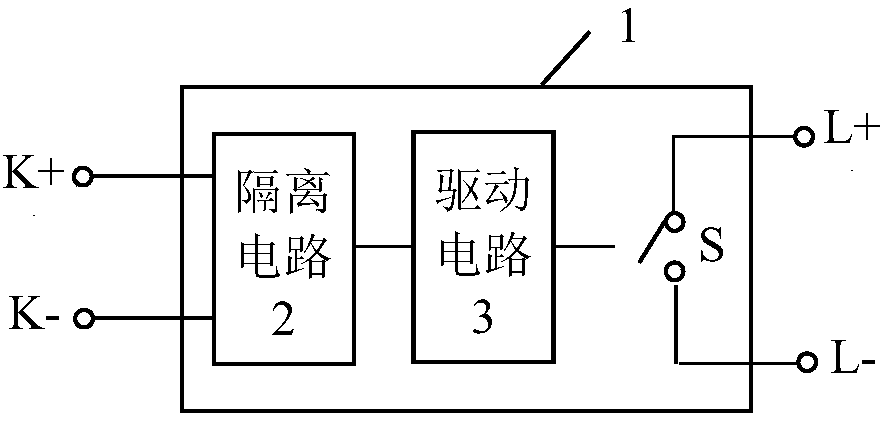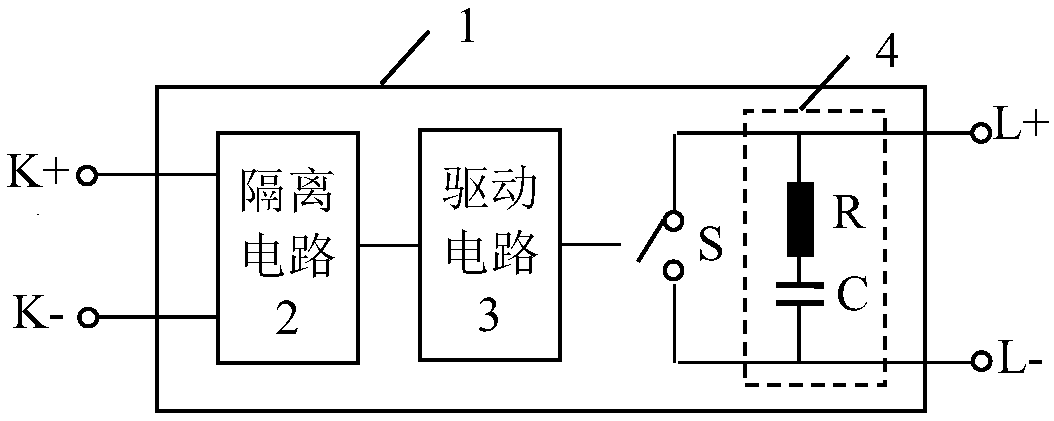Direct-current solid-state relay
A solid-state relay and DC input technology, applied in electrical components, electronic switches, pulse technology, etc., can solve the problems of inapplicability of solid-state relays, unfavorable power system energy saving, large volume, etc., and achieve obvious energy-saving effect, small volume, and simple circuit Effect
- Summary
- Abstract
- Description
- Claims
- Application Information
AI Technical Summary
Problems solved by technology
Method used
Image
Examples
no. 1 example
[0053] image 3 Shown is the principle diagram of the first embodiment of the present invention. This embodiment includes six terminals, namely DC input positive terminal Vin+, DC input negative terminal Vin-, DC output positive terminal Vout+, DC output negative terminal Vout-, control terminal positive Terminal K+ and control terminal negative terminal K-; also includes: shell 1, isolation circuit 2, drive circuit 3, first switch S1, second switch S2, first diode D1 and second diode D2; first The switch S1 is connected between the DC input positive terminal Vin+ and the DC output positive terminal Vout+, the second switch S2 is connected between the DC input negative terminal Vin- and the DC output negative terminal Vout-, and the anode of the first diode D1 is connected to the DC Output negative terminal Vout-, the cathode of the first diode D1 is connected to the positive DC input terminal Vin+, the anode of the second diode D2 is connected to the negative DC input termina...
no. 2 example
[0069] Figure 5 It is the principle diagram of the second embodiment of the present invention, compared figure 1 The difference is that a series circuit composed of a resistor R1 and a capacitor C1 is connected in parallel at both ends of the switch S1, and a series circuit composed of a resistor R2 and a capacitor C2 is connected in parallel at both ends of the switch S2.
[0070] It should be noted that the positions of the resistor R1 and the capacitor C1 can be exchanged, and the positions of the resistor R2 and the capacitor C2 can also be exchanged, which is equivalent to an RC series device after exchanging positions, which is common knowledge for those skilled in the art .
[0071] From t1 to t2, the current in switch S1 is shunted through the RC buffer branch composed of resistor R1 and capacitor C1, which reduces the burden on switch S1 and suppresses du / dt and overvoltage. When diode D2 is turned on at t2 , the current in the RC snubber branch is quickly transfer...
no. 3 example
[0075] Figure 6 It is the principle diagram of the third embodiment of the present invention, compared Figure 5 The difference is that a capacitor C3 is connected in parallel at both ends of the diode D1, and a capacitor C4 is connected in parallel at both ends of the diode D2.
[0076] From t1 to t2, a charging current will be formed in capacitor C3 and capacitor C4, which accelerates the absorption of current in switches S1 and S2, so that the current in switches S1 and S2 decreases and the peak voltage decreases, further suppressing du / dt and Overvoltage, so that the reverse voltage of diodes D1 and D2 will not be too large and be damaged by breakdown; when diodes D2 and D1 are turned on at t2 to form a absorption loop, capacitors C3 and capacitors C4 begin to discharge.
[0077] In this embodiment, there are certain problems in the switch-on process: when the switch S1 turns from off to on, the capacitor C4 is directly connected to the positive DC input and the negative...
PUM
 Login to View More
Login to View More Abstract
Description
Claims
Application Information
 Login to View More
Login to View More - R&D
- Intellectual Property
- Life Sciences
- Materials
- Tech Scout
- Unparalleled Data Quality
- Higher Quality Content
- 60% Fewer Hallucinations
Browse by: Latest US Patents, China's latest patents, Technical Efficacy Thesaurus, Application Domain, Technology Topic, Popular Technical Reports.
© 2025 PatSnap. All rights reserved.Legal|Privacy policy|Modern Slavery Act Transparency Statement|Sitemap|About US| Contact US: help@patsnap.com



